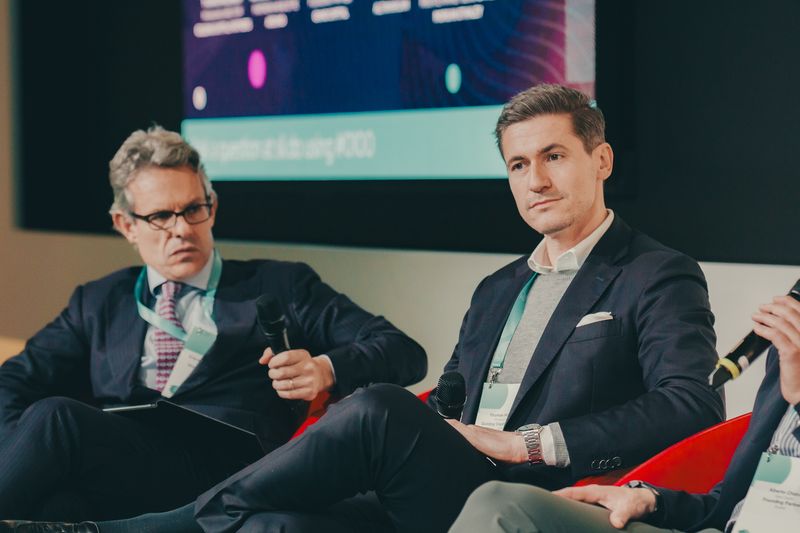The secondaries market is gaining significant momentum in the private equity and venture capital industries, making the panel discussion on "The Rise of the Secondaries Market in the Mediterranean Countries" a highlight of our recent 0100 Conference Mediterranean.

Moderated by Eriprando Guerritore of Greenberg Traurig, the session featured insights from panelists Thomas Hallinger (Golding Capital Partners), Ricardo Miró-Quesada (Arcano), Alberto Chalon (Giano Capital), Miguel Echenique (AltamarCAM), and Giuliano Gregori (Morgan Stanley). Together, they explored how the rise of the secondaries market in Mediterranean countries aligns with broader trends in private equity, marked by a growing interest in customized solutions that enhance liquidity, sustain asset quality, and foster sustainable growth.
Current Landscape and Demand in Secondaries
Thomas Hallinger from Golding Capital Partners outlined the impressive growth of the secondaries market, particularly in small and mid-market assets. With record levels anticipated in 2024, Hallinger noted a surge in both GP-led and LP-led transactions across the Mediterranean, fueled by heightened investor interest and a strong pipeline of assets prepared for secondary sales.

Alberto Chalon of Giano Capital highlighted the demand for single-asset secondaries within venture capital. With early-stage investors facing extended timelines to exit, the secondary market offers a vital liquidity option, particularly for founders and early employees. Chalon emphasized that by acquiring these single-asset stakes, Giano Capital enables investors to realize returns sooner, supporting the broader growth ecosystem.

Growth and Diversification of Strategies
Ricardo Miró-Quesada of Spanish firm Arcano discussed how the secondary market’s growth is tied to its expanding role within private equity. With private markets now exceeding $14 trillion in assets under management, the secondary market represents only a small portion—around 1%—of total assets, suggesting significant potential for expansion. He pointed out that the market is poised for further development as more investors turn to secondaries for portfolio management, seeking opportunities amidst a slowing distribution environment and increased capital calls.
Miguel Echenique of AltamarCAM echoed these sentiments, observing that GP-led secondary transactions have gained popularity as general partners (GPs) seek to retain quality assets. Echenique explained that GP-leds are becoming increasingly common, regardless of market conditions, as GPs leverage secondaries to maintain control over high-performing investments while generating liquidity for limited partners (LPs). The result is a versatile tool for balancing both investor needs and asset growth strategies.
Specialization and Quality in Asset Selection
Giuliano Gregori of Morgan Stanley noted his firm’s focus on GP-led secondaries, particularly single-asset deals. He explained that Morgan Stanley sees GP-leds as an ideal solution to sustain quality investments when exits are challenging. This trend is likely to continue as more firms recognize the benefits of holding trophy assets through tailored secondary structures, providing flexibility and liquidity regardless of market cycles.
Ricardo Miró-Quesada added that while secondaries present substantial opportunities, careful selection is key, particularly when evaluating single-asset GP-led transactions. He underscored that not all assets labeled as “trophy” warrant reinvestment. The panelists emphasized the importance of rigorous due diligence, portfolio architecture, and alignment between GPs and LPs in creating diversified, resilient secondary portfolios.

Secondaries Beyond Private Equity: Infrastructure, Credit, and ESG
The discussion shifted to the applicability of secondaries beyond private equity, with Hallinger and Gregori noting that asset classes like infrastructure and credit are gaining traction in the Mediterranean’s secondary market. Infrastructure investments, in particular, with their stable cash flows and extended timelines, are well-suited for GP-led structures. These deals enable longer-term holds and align with investor interest in resilient, income-generating assets.
On the ESG front, the panel emphasized that environmental, social, and governance (ESG) considerations are becoming essential in secondary investment strategies. Gregori shared Morgan Stanley’s rigorous ESG due diligence process, involving third-party consultants and ongoing monitoring. The panel agreed that ESG-focused investments often improve asset quality and are increasingly expected by investors as a standard, rather than an optional, component of private equity.
Challenges and the Future of Secondaries in the Mediterranean
In exploring the challenges of single-asset secondaries, the panelists agreed that finding truly high-quality assets and maintaining alignment with GPs were primary concerns. Miguel Echenique noted that investors need to be discerning, avoiding situations where GPs seek to “kick the can down the road” with suboptimal assets. A robust evaluation process—focused on asset quality, resilience, and alignment—is essential to ensure that secondary investments continue to perform and support long-term growth.
Closing the session, Thomas Hallinger reflected on the evolving fundraising landscape in secondaries. He emphasized that with a diverse array of strategies now available in the market, investors are showing increased interest in secondary funds, which provide both liquidity and stable returns. While the Mediterranean’s secondary market remains nascent, the continued inflow of capital and rising specialization across strategies—from LP-leds to GP-led single assets—indicates a promising future.




